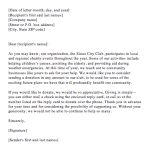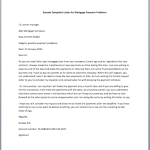A donation request letter is a formal letter with which nonprofit organizations, charities, schools and individual persons make appeals for money or in-kind contributions from prospective donors. It serves as an important fundraising tool designed to allow organizations to express their mission, further explain the purpose of the donation, and inspire generosity. When reaching out to individuals, corporations, or foundations, a good donation request letter has the potential to mean the difference between winning support and losing it. This letter serves as the first engagement with potential donors, setting the stage for all future relationships and encouraging continued contributions.
Donations letters are not for fund-raising only. They tell a good story that arouses emotion in the recipient, making them feel their support is needed. The letter should emphasize the urgency of a need, give insight into how donations would make a difference, and ‘encourage’ prospective donors by assuring them that their contributions will be used towards ‘great’ causes. A personalized model often works well when talking to donors (donors will give where they see that their generosity will create real change). Organizations should customize their letters for different audiences, taking into consideration the distinct interests and motivations of potential donors.
Key Elements of a Donation Request Letter
An effective donation letter adheres to a certain format in order to enhance the clarity and effectiveness of the audience. The letter starts with a warm and engaging introduction that acknowledges the recipient and sets the mood for future activities. The main body succinctly discloses the purpose or reason behind the letters attached: brief details about the target fundraising goal and how the money receives intended use. Specific projects, programs, or initiatives should be featured to show how the donation will make an impact on future decision-making processes on whether to contribute or otherwise. The letter provides call-to-action options to boost the number of recipients for contributions through easy donor channels and contacts.
Credibility and professionalism are important in persuasive writing when requesting donations. If you request donations on an organization’s letterhead and include a contact number, give information on its tax-exempt status to help legitimize the request and reassure the donor that it is being made in a transparent manner. Donor relationships will be strengthened with any display of appreciation whether this is in the actual letter or as a follow-up communication. Such display establishes goodwill that may help secure future support.
There is hardly any better fundraising instrument than well-assembled donation requests. It keeps alive the basic mechanism of establishing a relationship with donors. By blending emotion and clarity with a structured presentation and a solid call to action, organizations will greatly improve their chances of obtaining significant donations and sustaining their missions.
Sample Donation Request Letters
Here are previews and download links for these free Sample Donation Request Letters in MS Word format,
Types of Donation Request Letters
There is no single format for a donation request letter, the purpose, the audience, the type of donation being sought dictate the form of the request. Knowing what type of request to use for a particular type of audience will help an organization make effective requests for assistance thereby making it more probable that donations will be received. All donation request letters seek to promote the act of giving, however, they should be put in such a way that even the message has to be pleasing to the reader’s sentiments and purpose of the fund-raising event.
General Donation Request Letters
Most often, when registered charitable organizations such as nonprofit agencies, charities, schools, or a community wants to conduct a project in its area or wants to enhance its wellbeing programs, it writes a general donation request letter. The purpose of this sort of note is to explain the objective of the organization, report on previous full-filled projects, and try to convince the receivers that there is a basis for requesting help in terms of a donation. Usually, this letter is addressed to previous donors as well as prospective patrons and business firms in the vicinity that could consider making a donation towards a worthy cause.
Corporate Sponsorship Letters
Businesses are major contributors to charities and corporate sponsorship letters are aimed at bringing companies on board for fundraising or selected projects. The key element of these letters is that they seek to obtain sponsorship by showcasing benefits to the sponsors’ Corporates in terms of CSR and enhancing public standing. Organizations usually invite businesses to support their events by promising them pertinence, and most often offering to display the company’s relief graphic symbol on the event materials and its mentioning in advertising campaigns. Such a letter is printed for, among other reasons, charity functions, societies, and many other non-profits that want businesses to sponsor them over a long period of time.
In-Kind Donation Request Letters
Financial support is not the only way to contribute to a cause; that is why in such cases, an in-k kind donation request letter is written when writing to ask for donations in goods or services rather than cash donations. For example, a non-profit seeking donations of certain items may request food and clothing, school supplies, or even professional services, such as graphic design, printing, accounting, or legal advice amongst others. All of these kinds of letters include a clear description of what is being requested, why it is needed and how the donation will benefit the social cause or the project for which the resources are requested. Most people and companies that do not offer money most of the time react appropriately towards a request to make a donation in kind.
Event-Specific Donation Letters
It is not uncommon to see fundraising activities develop around a particular activity or event – such as an organic campaign where each donation request letter may be designed specifically to solicit guests or sponsorship, offering prizes, or raising funds. Such state the intentions of the occasion, the type of people in attendance and the manner in which those who donate will be recognized. Such endeavors include auctions, balls, runs, and local social services activity for example and in these announcements the goal is to get the people to register and to chip in with money so as to make the event successful.
Online and Email Donation Appeals
The growth of digital fundraising has brought about more effective use of donations appeals via the internet or email. In addition, these letters are not as long and very explicit: they include links to donation platforms making it easy to take action instantaneously. And hence, they employ evocative narratives and the pressure of time and speed for quick donation. So most of the time such letters tend to be used in social media campaigns and crowdfunding campaigns to extend their reach to a wider audience on the internet.
Different types of donation request letter create an appeal that is focused on the donors and thus organizations have an opportunity in their fundraising efforts as well as nurturing a good relationship with the donors.
Common Mistakes to Avoid in Donation Request Letters
Though a donation request letter may be a very effective tool for securing funds, a lot can go wrong with the writing that can discourage the fundraising mission. Towards this end, the request must be clear, touching and focused on achieving the desired objective. The organizations have to be very tactful when making requests and not make any mistakes that may render the requests weak or lack the motivation to give.
Lack of Personalization and Connection
A donation request letter is not a form letter and one of the popular mistakes made when writing these types of letters is not addressing the receiver specifically. Sending a “Dear Supporter” letter instead of addressing the individual by name lessens the letter’s professional tone. Human beings respond to, and associate action with causes, and l will help if donors or businesses are addressed by name. The more detailed the message, the more the organization tends to the donor’s needs, and the better the response rate will be. A target individual implies that the company is appreciative of the recipient, since they know that the person may be of help in the support of the cause.
Vague or Unclear Purpose
A poorly written donation request letter is often obscure about the necessity of the donation and its proposed use. Donors are interested in knowing what exactly their donations can achieve. For example, a generalized appeal like “Help us with our cause,” does not have sufficient information to instill confidence. Instead of this, the letter should specify explicitly who the project or the plan or the organization is that will receive the donation. Example: the cost of providing food for children or assistance to the sick in hospitals makes it easier to see what the potential responds can be efficient.
Weak or Missing Call to Action
One of the purposes served by a donation request letter is encouraging the reader to act; however, many letters do not contain an effective call to action. A letter asking for donations which fails to give it’s readers guidelines on how they could pitch in is ineffective in oblivious ways. There must be a brief directive which should follow after all the stories, facts and emotions that would tell the person planning to donate what to do next attaching for example a link to an online donation or even ways of sending a cheque. It makes enough sense as one likely conclusion that visitors may not take any further steps when the letter is only filed away and forgotten.
Overlooking Gratitude and Follow-Up
Donors who are not appreciated leave many of the organization’s prospect donors unappreciated, and thus much less willing to give their resources. Although some insist on writing brief donation request letter where receipts are always requested and thank you in anticipation of donation welcomed, there are some organizations who heed not thanking or even abuse the past. Appreciation doesn’t mean only giving thanks to the donor in a letter – it also serves to promote good social practices within the organization. Similarly, writing a thank you letter or even a message after a donation cannot be ignored since it is good for the receiver. Appreciating benevolence fosters more communication in the inks and makes it clear that the other party’s contributions are appreciated.
It is important to approach a donation request letter with caution because persuasion, explanation, and behavioral modification are central to its composition. Within this framework, using generalized or inappropriate personalization or a cryptic phrase in a request or thanking someone’s help should be avoided because they are always possible – especially, when a person wants something very much. Organizations can produce fascinating fundraising campaigns that achieve all of the objectives mentioned above. Writing a great letter will, of course, attract the donors at that moment, but it will also assist in building the rapport with donors that will help solicit for more donations in the future.
Keep in touch for future updates on this topic to grab more free templates.











































